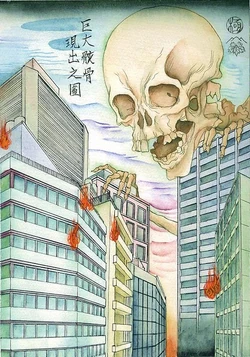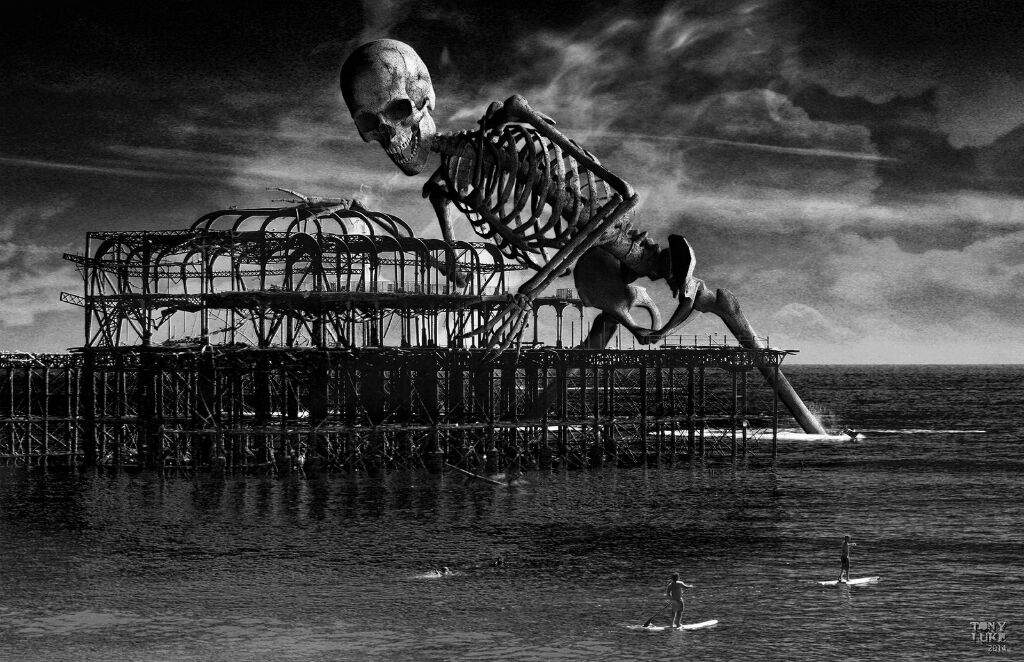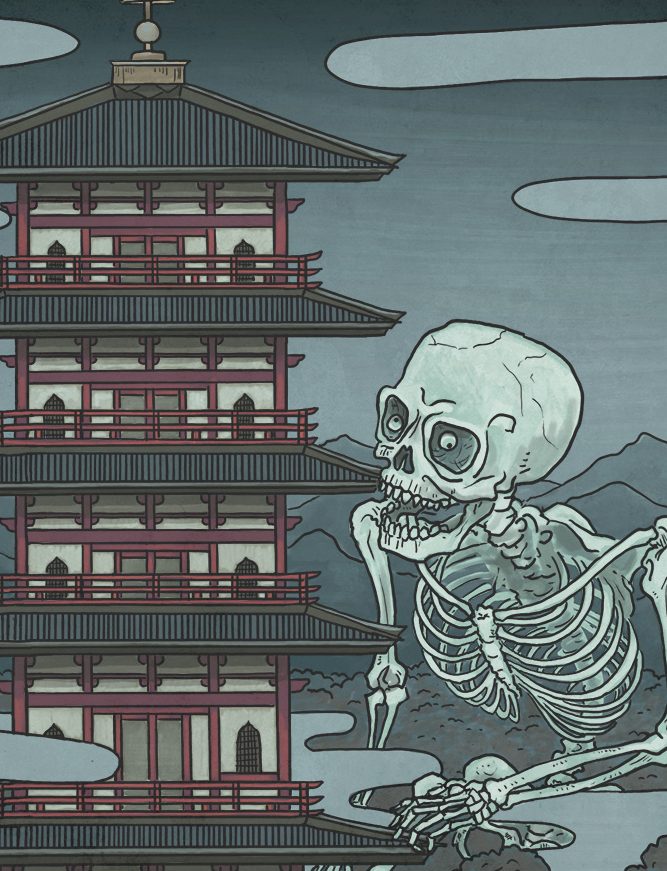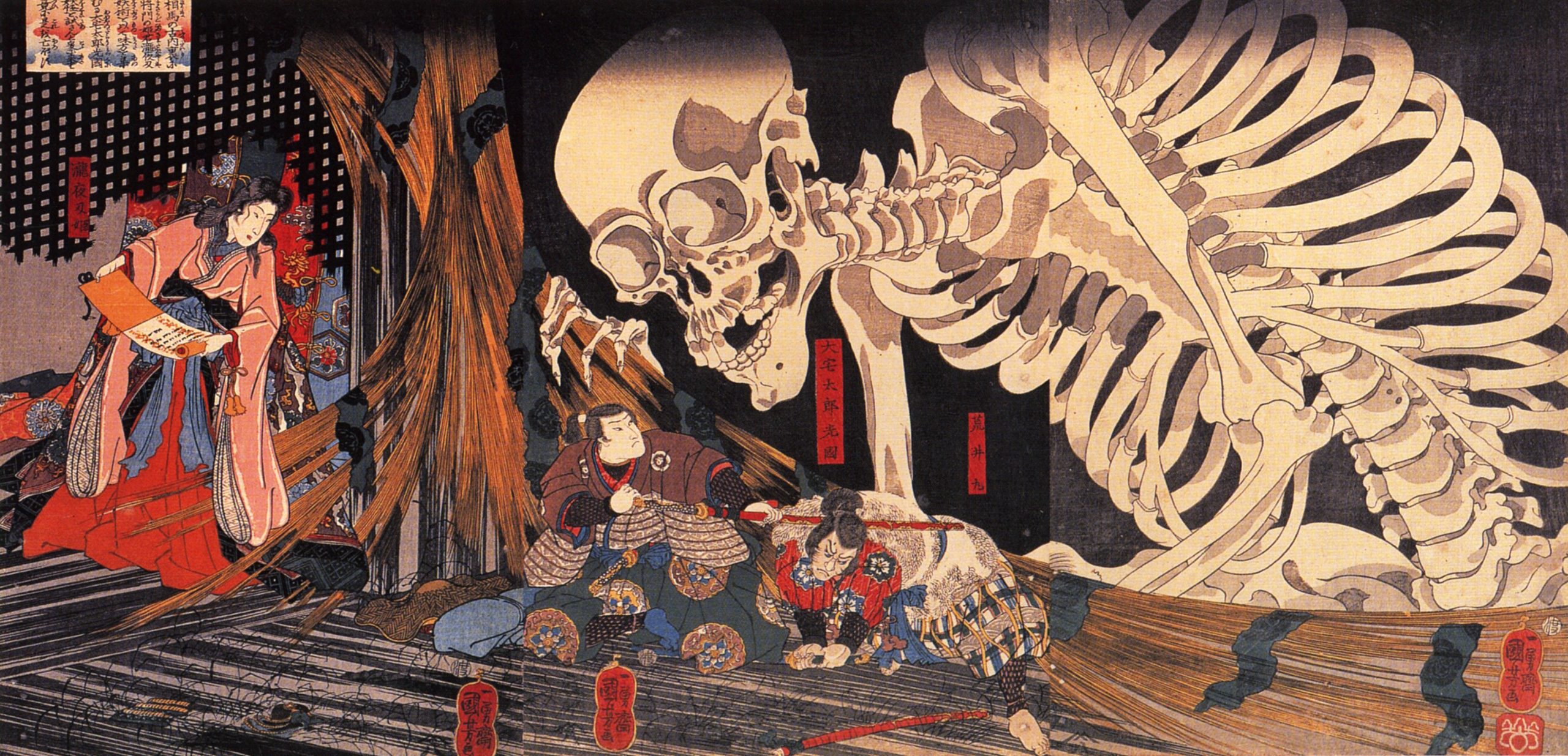The Gashadokuro legend is a chilling tale deeply embedded in Japanese folklore, captivating the imaginations of many with its bone-curdling narrative. This legend revolves around the fearsome Gashadokuro, often referred to as the Bone-Eating Giant.

What is Gashadokuro?
Gashadokuro, also known as Oodokuro (giant skull), is a supernatural entity that holds a prominent place in Japanese mythology. It is believed to be an enormous skeletal being, towering over its victims and invoking paralyzing fear in those unfortunate enough to encounter it. The name “Gashadokuro” is derived from the combination of two Japanese words: “gasha,” meaning “rattle,” and “dokuro,” which translates to “skull.” This name aptly reflects the eerie sound emitted by Gashadokuro as it moves, sending shivers down the spines of those who hear it.
According to the legend, Gashadokuro is formed from the accumulated bones of people who died in battles or were left unburied. Over time, these forgotten remains merge together, giving rise to a colossal skeletal entity driven by malevolent intentions towards the living.
Gashadokuro is often associated with the concept of yūrei, which are malevolent spirits or ghosts in Japanese mythology. These spirits are believed to be the restless souls of the deceased who have not found peace due to unfinished business or neglectful burial practices.

The Legend of Gashadokuro
The legend of Gashadokuro is closely intertwined with the spiritual beliefs and customs surrounding death in Japanese culture. It serves as a cautionary tale, emphasizing the importance of showing respect to the deceased and honoring their memory through proper burial rituals. Neglecting these responsibilities can lead to the transformation of neglected remains into vengeful entities, such as Gashadokuro.
Gashadokuro is said to emerge primarily during the dark hours of the night, lurking in desolate and forgotten places. Its immense size, depicted as towering over buildings and landscapes, instills bone-chilling fear in those unfortunate enough to come across it. The creature possesses an insatiable hunger for human flesh, relentlessly pursuing its prey with an otherworldly appetite.

The Mythology Behind the Giant Skeleton
More than a millennium ago, the Gashadokuro made its first recorded appearance, tracing back to a turbulent period in Japan’s history marked by a violent rebellion against the central government led by a samurai named Taira no Masakado. Among the notable figures involved in this rebellion was Masakado’s daughter, Takiyasha Hime, renowned for her mastery of sorcery and mystic arts. Even after her father’s demise, Takiyasha Hime carried on his cause, determined to avenge his death and challenge the powers that be.
Harnessing the dark forces of black magic, Takiyasha Hime summoned forth a colossal skeletal creature from the remains of fallen soldiers, constructing an abomination to unleash upon the city of Kyōto. This fearsome monster, known as the Gashadokuro, became the embodiment of her vengeful desires and her unwavering commitment to her father’s rebellion. Its towering form struck terror into the hearts of those who gazed upon it, a testament to both Takiyasha Hime’s mystical prowess and the boundless wrath of the fallen warriors.
The tale of Takiyasha Hime and her conjured monstrosity has been immortalized in a renowned print by the esteemed artist Utagawa Kuniyoshi. This artwork captures the essence of the Gashadokuro’s menacing presence as it rampages through the city, a visual testament to the power of sorcery and the consequences of defying the established order.
Through the ages, this legend has endured, captivating the imaginations of many and serving as a cautionary tale about the dangers of unchecked power and the consequences of rebellion. The story of Takiyasha Hime and her creation, the Gashadokuro, serves as a reminder of the delicate balance between the realms of the living and the dead, the potential consequences of dark magic, and the eternal struggle for justice and revenge.
As the legend of Gashadokuro continues to be passed down through generations, it remains a testament to the enduring power of folklore and the rich tapestry of Japanese mythology. The story of Takiyasha Hime, her summoning of the mighty Gashadokuro, and the print by Utagawa Kuniyoshi serve as a timeless reminder of the human spirit’s capacity for both creation and destruction, as well as the profound impact that legends and mythologies can have on our collective consciousness.

Encounters with Gashadokuro
While encounters with Gashadokuro are rare and predominantly confined to the realm of folklore, those who claim to have witnessed this terrifying creature recount harrowing tales of their experiences. Witnesses describe an overwhelming sense of paralyzing fear as Gashadokuro emerges from the shadows, its elongated limbs and skull-like visage casting an ominous pall over its surroundings.
Gashadokuro is believed to possess immense strength, capable of crushing its victims with its massive skeletal hands or tearing into flesh with its razor-sharp teeth. Its presence is accompanied by an eerie atmosphere, a palpable malevolence that fills the air and freezes the hearts of those unfortunate enough to be near it.

Protective Measures against Gashadokuro
Gashadokuro embodies the lurking danger that hides in the darkness, waiting to prey upon those who are unaware or neglectful of their responsibilities toward the deceased. The creature has the ability to hide itself, sneak up on people and strike fear into unsuspecting victims
Japanese folklore offers various protective measures to ward off Gashadokuro. These precautions often revolve around fulfilling one’s obligations to the dead, maintaining proper burial rituals, and showing utmost respect for the deceased. By doing so, individuals seek to avoid incurring the wrath of vengeful spirits and prevent the transformation of neglected remains into malevolent entities like Gashadokuro.
Conclusion
The Gashadokuro legend stands as a testament to the rich tapestry of Japanese folklore, embodying the fears and beliefs surrounding death and the supernatural. It serves as a chilling reminder of the consequences of neglecting one’s spiritual duties and failing to honor the memory of the departed. Gashadokuro, lurks in the shadows, its presence evoking terror in those who dare to cross its path.
Gashadokuro in Pop Culture
- Anthony Bourdain’s book “Anthony Bourdain’s Hungry Ghosts” includes a story/recipe called “The Starving Skeleton” that features the creation of a Gashadokuro, made when a chef refused to feed a starving homeless man.
- Gashadokuro is featured in the anime/manga/card game Yu-Gi-Oh! as a Level 11 Zombie Synchro monster from the Mayakashi Archetype, manifesting as a giant skeleton decked-out in Samurai armor.
- In the manga Bone Collection, Gashadokuro are SS-rank youkai who possess a different power in each bone. The protagonist’s partner and love interest currently appears mostly human as a result of her attempts to seal her power, but she is shown in flashbacks as a skeletal (albeit human-sized) demon.
- The modern depiction of Gashadokuro was made famous by the Japanese writer Morihiro Saito. Giant skeletons were a somewhat common motif in older folktales, but most of the Gashadokuro’s specific attributes come from Saito.





